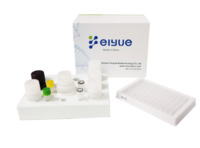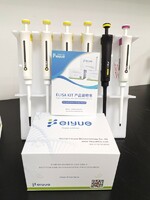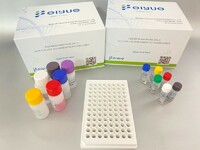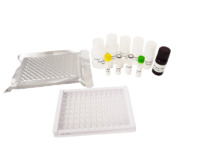Chicken Total Bile Acid (TBA) ELISA kit
Specifications
TBA (Total Bile Acid) Introduction
Bile Acids (BA) make up 67% of the total composition of bile. They are 24-carbon steroids generated during cholesterol metabolism. They form conjugates with either glycine or taurine to form bile salts. Five of the bile acids account for more than 99% of the total population found in biofluids. The average composition in healthy individuals includes conjugates of cholic, chenodeoxycholic, deoxycholic and lithocholic acids. Bile acids are critical due to their ability to solubilize lipids by forming micelles with cholesterol, and fatty acids. Their synthesis is not only critical for the removal of cholesterol from the body but they are also needed for proper uptake of dietary lipids into the small intestine. The measurement of circulatory Total Bile Acids (TBA) therefore provides information about hepatic functions and liver diseases such as jaundice, and hepatocellular injury. TBA estimation can detect liver damage during early stages and permits patients to get treatment before hepatic damages become irreversible. In addition, bile acids participate as signaling molecules interacting with G-protein coupled receptors (GPCR), TGR5, and nuclear receptor farnesoid X receptor (FXR).
Chicken TBA (Total Bile Acid) ELISA kit Test Method
This kit was based on Competitive-ELISA detection method.
The microtiter plate provided in this kit has been pre-coated with target. During the reaction, target in the sample or standard competes with a fixed amount of target on the solid phase supporter for sites on the Biotinylated Detection Antibody specific to target. Excess conjugate and unbound sample or standard are washed from the plate, and HRP-Streptavidin (SABC) is added to each microplate well and incubated. Then TMB substrate solution is added to each well. The enzyme -substrate reaction is terminated by the addition of a sulphuric acid solution and the color change is measured spectrophotometrically at a wavelength of 450nm. The concentration of target in the samples is then determined by comparing the OD of the samples to the standard curve.
Bile Acids (BA) make up 67% of the total composition of bile. They are 24-carbon steroids generated during cholesterol metabolism. They form conjugates with either glycine or taurine to form bile salts. Five of the bile acids account for more than 99% of the total population found in biofluids. The average composition in healthy individuals includes conjugates of cholic, chenodeoxycholic, deoxycholic and lithocholic acids. Bile acids are critical due to their ability to solubilize lipids by forming micelles with cholesterol, and fatty acids. Their synthesis is not only critical for the removal of cholesterol from the body but they are also needed for proper uptake of dietary lipids into the small intestine. The measurement of circulatory Total Bile Acids (TBA) therefore provides information about hepatic functions and liver diseases such as jaundice, and hepatocellular injury. TBA estimation can detect liver damage during early stages and permits patients to get treatment before hepatic damages become irreversible. In addition, bile acids participate as signaling molecules interacting with G-protein coupled receptors (GPCR), TGR5, and nuclear receptor farnesoid X receptor (FXR).
Chicken TBA (Total Bile Acid) ELISA kit Test Method
This kit was based on Competitive-ELISA detection method.
The microtiter plate provided in this kit has been pre-coated with target. During the reaction, target in the sample or standard competes with a fixed amount of target on the solid phase supporter for sites on the Biotinylated Detection Antibody specific to target. Excess conjugate and unbound sample or standard are washed from the plate, and HRP-Streptavidin (SABC) is added to each microplate well and incubated. Then TMB substrate solution is added to each well. The enzyme -substrate reaction is terminated by the addition of a sulphuric acid solution and the color change is measured spectrophotometrically at a wavelength of 450nm. The concentration of target in the samples is then determined by comparing the OD of the samples to the standard curve.
- Contact: lottie Shi










